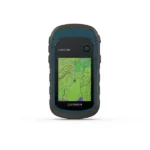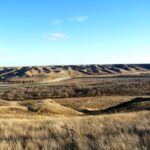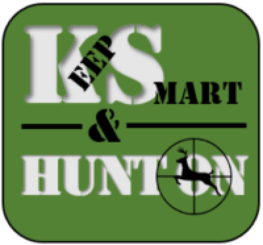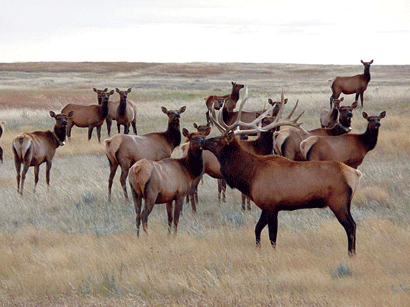If you are looking for an established/counted elk herd to hunt, you are starting in the correct place by reviewing the CFB Suffield Elk Hunt.
From 220 transplanted animals in the late 1990s to approximately 8,000 as we moved past 2010. This has created a long sought after situation for elk hunters.
The area has now become known as WMU 732. Open for Elk draws through the cooperation of CFB Suffield, Alberta Environment and Protected Areas, as well as Alberta Fish and Wildlife. As of this post (2022 season) it is estimated that the herd size is around 3,000 animals with 8,334 animals taken over the previous 10 years.
As of the 2022 season Alberta Fish and Wildlife have been issuing two tags for Antlerless Draws (needing a priority of 1). Antlered draws (needing a priority of around 5, and all bulls with 4″ or more are valid) will receive a single tag.
Depending on what social media groups you look for reviews on, you will get the full spectrum of love through hate for this hunt. We will try to break it down and give you a realistic (as impartial as we can be) perspective.
We will go through what is needed in Preparation for the hunt, the Rules and Procedures that were in place when we attended, the hunting area and access you will be granted, what type of hunting you can expect, and our opinion whether it is worth it.
CFB Suffield Elk Hunt – Preparation
Draws
First and foremost you need to put in for your draw tags. If you are unfamiliar with how to do this, you can find out how at: MWA (My Wild Alberta). Remember the CFB Suffield Elk hunt is a number of 3-day hunts throughout October until the end of January. Make sure you pick the timing that works best for you as these tags are only valid for the specific week of your draw.
Minimum Requirements
CFB Suffield is an active military base, and the hunt area includes a live munitions training area. The roads in this area range from gravel, through to soft sand, and in some cases no roads at all, just the natural terrain. All of this combined with the fact that Alberta has a tendency to have snow and ice in the later parts of the hunting season.
Other factors that come into play is that the hunting area is divided into 3 sections. A main hunt area. This area you are allowed to drive basically anywhere your vehicle can take you, whether on road or off-road. The other two areas are on the Eastern edge of the base and consists of an NWA (Natural Wildlife Area) which is divided into two sections (a North NWA and South NWA).
The North and South NWAs are only accessible to those that have entered their names into a draw at the beginning of the day (we will talk more about this later). These areas are also limited in access. You may only drive on a handful of designated roads in each area. All other access is by foot, and no vehicles of any kind are allowed off those designated roads. (If you break that rule you will be taken into custody and turned over to Alberta Environment and Protected Areas, and possibly charged, as well as being banned from the hunt.
The base personnel will not assist with any vehicle issues or animal recovery from any area, and the NWA draws are not open to individual hunters. (You either have to have a “Helper” with you or another hunter to enter those daily draws). Those draws also have minimum mandatory equipment that you must provide, as well as recommended equipment.
Equipment List:
- Basics:
- Due to the road conditions it is recommended to have a 4×4 truck or 4×4 SUV with good all terrain tires
- Government issued Photo ID
- PAL
- Hunting License(s)
- Issued Tag(s)
- Hi-visibility clothing (required – Jacket or vest) a Hi-vis hat is also recommended
- Firearm (only one can be unlocked and uncased per hunter at any time) a spare one locked and cased is permitted
- Ammunition
- Recommended (Recovery items for both your vehicle and your potential elk harvest)
- Coulees are difficult to judge distance, so a range finder is also recommended
- Fuel Plan (in-case you run out of gas in the field)
- Food/Water for you hunt
- Additional Requirements (if you are intending to enter the draw for the NWA walk in areas only – these items will be verified upon entry through the gates into the hunting area):

-
- A second person (no one is allowed to hunt the NWA areas as a solo hunter, you need a second hunter with license and tags, or at least one helper.
- A flashlight (spare batteries will also be beneficial)
A dedicated GPS (not your phone) or a compass
-
CFB Suffield – Procedures and Rules
You should be able to guess that given this is a military base, and coordinated by the base personnel that there are numerous procedures in place, and they run quite smoothly.
Arrival:
All hunters are required to attend a Daily Briefing in order to enter the hunt area. This briefing takes place at the CFB Suffield Recreation Centre parking lot. The parking lot officially opens at 06:00 but you will find that a number of hunters will arrive early and start lining up their trucks outside the parking lot and around the perimeter road (Dugway Dr.).
Pro Tip: The “draws” for the NWA walk-in areas were directly impacted by how early you arrived (when I attended), So arriving between 5:30 and 05:45 allowed me to be “drawn” each day for the 3 days.
When the base personnel open the parking lot, they will approach each vehicle, and get the names of the hunters (on the first day). Each additional day they verify the hunter and helpers in each vehicle. You will also be asked if you want to enter into the NWA draw. If so, will need to indicate whether you wish to apply for the North or the South. This will then result in you verifying you have the above listed required items, and they will record your license plate number.
All vehicles will be pulled into the parking lot, and lined up in rows (directed by the base personnel). You will receive a package per hunter, and a package per helper. This has basic paperwork to fill out containing contact information, waivers, etc. Your helpers will receive a wrist band that indicates they are a helper, and if you have not requested entry to the draw areas you will receive a hunter wrist band. If you entered the draw you will receive a wristband at a later time, with its colour determined by whether you were drawn or not.
The package will also contain a map of the hunt area (which you will have to turn in at the end of the week), and a PowerPoint presentation to follow along with. The PowerPoint will within the first couple of pages reference an FM station that you must tune your radio into. This station will broadcast the morning brief starting at approximately 06:45, and you will follow along with the PowerPoint.
After the brief the hunters will be allowed to exit the parking area, and you will head to one of two entrance gates depending on the direction given in the briefing.
Things to Make Note of:
- You must attend the briefing each day to gain access to the hunt area (access passes are issued and collected each day)
- All Hunters and helpers must be 18 years of age or older.
- As indicated NWA hunters will need to show the required items listed above prior to accessing the hunt area
- The base will not assist with vehicle or animal recovery
- They provide telephone numbers of tow companies in the morning package
- If the vehicle is stuck in the evening you will need to arrange for transportation back to where you are staying, and back to the base in the morning. Tow trucks will be escorted by Base Personnel.
- There is a specific time when all vehicles have to be off the base (having exited through a single designated gate) – this was 18:00 when I was present
- If you are unable to make this cut-off, you must call the gate and make them aware of the situation (if you fail to call, they will call you)
- It will take a minimum of 1 hour to get from the North East corner of the hunt area to the designated exit point
- If you harvest an Elk late in the hunt, you will be required to record the location, notify the base, and you will recover the animal the next morning, as opposed to staying on the base late into the evening
- The base will have a designated speed limit for hunters which will take precedence over any posted signs
- Hunters must have their hi-viz on anytime they are outside of their vehicles
- All hunters must stay within the areas they have been granted access to
- When interacting with Base Personnel (at briefings, gates, etc.) you are to stay in your vehicle unless asked to exit
- When exiting you can submit heads for CWD testing (optional). Heads must be removed prior to arrival at the gate
- Your vehicle will be searched/check
- There is NO alcohol or marijuana allowed on the base, and there is no removal of any items from the base that you did not bring yourself (except your harvested elk). Sheds etc. are not allowed to be taken.
Violation of the rules could result in you being removed/banned from the base. You may also be turned over to additional authorities for further action (i.e. Alberta Environment and Protected Areas if you drove on unauthorized trails in the NWA areas, or Alberta Fish and Wildlife if you have violated any hunting regulations).
CFB Suffield Elk Hunt – The Hunting Area and Your Access
The whole area consists of 2,691 Square Km to hunt within. The far Eastern edge of the hunting area is the NWA draw areas, and it is broken into a North and South section. In the morning brief you will have been issued an access pass which is valid for either the Main Hunt Area, or one of the NWA areas. If you have a Main Hunt pass you will not be allowed in the NWA areas. If you have an NWA pass you will be allowed in the specific region (North or South) as well as the Main Hunt Area.
Within the Main Hunt Area, you can drive anywhere you think your vehicle will be able to travel. If there are any temporary out-of-bounds areas they will be indicated in your morning packages/briefing. Keep in mind this is a live ammunition training facility, so there is a chance that there may be UXO (unexploded ordinance) – hence the liability waiver.
Within the NWA areas, you will be given a list of several roads for each region that you are allowed to drive on. Other than those roads, you are not allowed to take a vehicle onto any other land or trails.
The Terrain:
If you do not know what Coulees are, you may want to google them – or click HERE. This particular hunt area is not a forested area. You are in a large open area filled with various hills and ravines. These hills and ravines can range from a few metres/yrds to more than 500yrds or roughly 0.5km in height.

This part of Alberta is also somewhat of a desert, so you have cacti and low brush without a lot of large fully developed trees. The ground is soft and sandy is some areas as well, which could impact your ability to drive in certain areas. Please keep in mind it is still Alberta, so expect sow during the hunting season.
Given the terrain, you can see for long distances, but the hills make it easy for animals to disappear into the dips and valleys. It is also very difficult to judge distances given how far you can see. Given the elevation changes during any hike, you need to ensure you are in decent shape, or at least know your limits.
I would also recommend snowshoes for hiking as the snow can become relatively deep, and with the winds in the area the top forms a crust which makes walking even more difficult when you break through the surface (which happens far to often).
CFB personnel also does not necessarily ensure all roads you are allowed to use are cleared, so roads are (use at your own risk) and many can be unusable during each hunt.
What You Can Expect / The Experience
Expect long waits, repetitive instructions, shortened hunting days (you get into the hut area around 08:20 or later, and have to travel the base to the exit point for 18:00). Also a lot of hunters (140 hunters) which does not include all the helpers, and officials scattered through the hunt areas.
Aside from that expect a somewhat typical Crown land hunt. You will periodically be all by yourself, and other times see hunters as you turn corners. There are lots of animals on the base that are not huntable, so they just add to the scenery. If you like to road hunt, you have plenty of access to do that within the 2,600+ square km area. Then, when you are tired of sitting or running into other hunters you park and head into the hills on foot.
The base staff are incredibly friendly and will chat and joke around with you, while keeping everyone on track and time. They will even share whatever information they have on the whereabouts of elk or even the herd if they know where it is on any given day.
All other officials are just as relaxed (if you are following the rules). If they have seen elk they will share the rough locations, and they will also let you know where animals had been taken from the previous days of the week, and in the previous weeks’ hunts. We were told about a handful of elk spotted on the day we were talking to one Fish and Wildlife Officer, and he also shared with us where the large herd was (over 1,000 animals) the week earlier, and gave us a secondary recommendation for where to walk in that might increase our chances of discovering larger pockets of elk.
Hunters are exactly as any I have encountered throughout Alberta. Some wave and move on by without talking, others will stop and chat with you. This usually results in sharing of information about road conditions, animal sightings, and even elk sightings. Beyond that, they are helpful. There were a few instances where hunters helped pull others out of messes they got into.
We were part of that group. My truck didn’t have the muscle necessary in one case, given how deep someone’s truck had sunk, but I had the gear, and another hunter had the torque. Between the two of our groups we were able to get someone back on the road that was very close to being stuck and requiring very expensive 4×4 Tow Truck bill to get out.
If you are a walking hunter, expect a lot of elevation changes but long lines of visibility. Expect to put a lot of miles on once you start walking, and if you aren’t used to coulee hunting, expect to get tired, and impressed with how far away your truck can feel when you start heading back.
As far as results are concerned. They will vary. The base seems to hope for roughly 100 animals to be taken per hunt week. We were told of the week prior to us having a 39 head day on the first day of the hunt. The week we attended the combined total for the week did not even hit 39 animals. So somewhat similar to any other hunting outing. A lot of preparation, but some of it also comes down to luck on the particular day(s).
Is It Worth It?
If you ask us, the answer is YES. It was a new experience, where we encountered a lot of great people and got out into nature and away from work. All things that are important to us. Harvesting an Elk would have been a huge bonus, but as I said, the week we attended did not have a high success rate. Does that change our opinion about whether we would do it again? Absolutely not.
The things you have to factor in to answer this question for yourself are:
Why am I hunting? If it is purely for meat or a trophy, 3 days is a short window. So you may want to ask if you have other opportunities that could be as successful where you would have a longer time to pattern the animals, etc.
Where do you live, and what travel is required? We traveled roughly 5 hours and stayed in a hotel in Medicine Hat, commuting the 45 minutes or so each morning and evening. Driving down after work on Tuesday, getting up each morning at 04:30 and incurring 3 days worth of hotel bills as well as approximately an extra 1,000 km of driving. That being said we also met hunters that live just outside the base. Is this worth it for you?
Can I handle crown land hunting, or do I like private land? This is not like private land hunting, so if you can’t handle the crowds, etc. of crown hunting, then maybe this isn’t for you.
Ultimately, we crown land hunt a majority of the time, and despite the horror stories we have seen published by some people about the chaos involved in this hunt, we didn’t really feel the hunt itself was much different from your average hunting day out on any other crown land.
We did the late season which allowed us to extend our hunt season a little longer, so we would less withdrawal before bear season starts again. This was not offset or overpowered by the fact that we had to sit through a briefing each morning or had hard cut-off times to exit the area. We follow hunting regulations, and are ethical hunters, which meant that we didn’t encounter any issues on the base.
If travel, additional cost, or crown hunting will make you complain, then perhaps see if you have elk in a more suitable location for your preferences. If you are OK with those items, then I say don’t worry about the horror stories, go in knowing that there will be lineups and delays each day prior to getting the hunt started, and then enjoy your time when they finally let you out of the parking lot.
Thank you from a Hunting Couple

